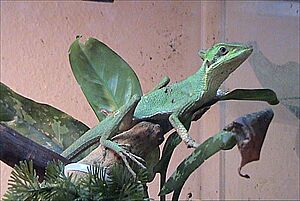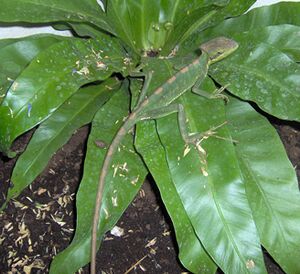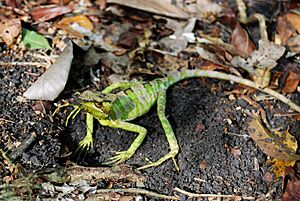Eastern casquehead iguana facts for kids
Quick facts for kids Eastern casquehead iguana |
|
|---|---|
 |
|
| Laemanctus longipes | |
| Conservation status | |
| Scientific classification | |
| Genus: |
Laemanctus
|
| Species: |
longipes
|
The eastern casquehead iguana (Laemanctus longipes) is a cool type of lizard. It belongs to the family called Corytophanidae. These lizards are originally from Mexico and Central America.
Contents
Where Does the Eastern Casquehead Iguana Live?
The eastern casquehead iguana lives in several places. In southern Mexico, you can find it in the states of Colima, Oaxaca, Veracruz, and Yucatán. It also lives in Central American countries like Belize, Guatemala, Honduras, and Nicaragua.
What Does the Eastern Casquehead Iguana Look Like?
These iguanas are long and thin. They can grow up to 70 centimeters (about 27.5 inches) long. A big part of their length, about two-thirds, is their thin tail!
The scales on their forehead are much bigger than the scales on the back of their head. They don't have pointy scales sticking out from the back of their head. The scales under their throat (called gular scales) have two or three ridges.
Boys and Girls Look Different
It can be a bit tricky to tell male and female iguanas apart. This is called Sexual dimorphism. Males usually have a slightly thicker tail base than females. Sometimes, if you gently lift a male's tail, you might see parts of their reproductive organs (called hemipenes).
Different Types of Eastern Casquehead Iguanas
Scientists recognize two main types, or subspecies, of the eastern casquehead iguana. A subspecies is like a slightly different version of an animal within the same species.
- Laemanctus longipes deborrei was named by George Albert Boulenger in 1877.
- Laemanctus longipes longipes was named by Arend Friedrich August Wiegmann in 1834. This is the main type.
Where Do They Live?
The eastern casquehead iguana likes to live in tropical forests. These can be very wet, moist, or even forests that have a dry season. They can also live in areas where trees have grown back after being cut down, as long as there are good trees for them to climb.
How Do They Live?
These iguanas are arboreal, which means they spend most of their time high up in trees. They are quite slow movers. You might see them sitting on trees or bushes, especially near water. They often lick water drops off leaves. They also catch insects that walk by.
Eastern casquehead iguanas usually live alone. Sometimes, you might find one male living in a territory with one to three females. But often, males and females only meet when it's time to mate. This can happen several times a year.
How Do They Reproduce?
L. longipes are oviparous. This means the females lay eggs.
What's in a Name?
The name deborrei for one of the subspecies is a special tribute. It honors a Belgian scientist named species:Alfred Preudhomme de Borre (1833–1905). He studied insects, which is called Entomology.
Can They Be Pets?
Some people keep eastern casquehead iguanas as pets. However, they are not easy pets for beginners. They can get dehydrated very quickly. It's super important to mist their enclosure daily or have a system that drips water for them.
The temperature in their home should be warm during the day, between 25 and 35 °C (77 and 95 °F). At night, it can be a bit cooler, around 20 to 23 °C (68 to 73.4 °F). They also need high humidity, between 70 and 90%.
These iguanas mostly eat crickets. They should get at least four or five adult crickets every day. They also need special UVA and UVB lights. Plus, they need extra vitamins and calcium once a week to stay healthy.




